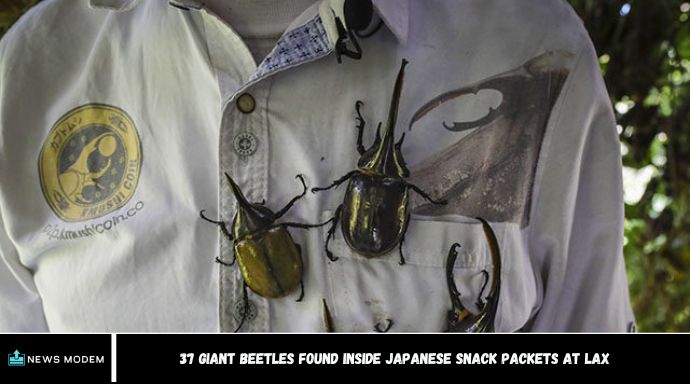37 Giant Beetles Found Inside Japanese Snack Packets at LAX At least 37 giant live beetles, measuring 4 to 5 inches long, were discovered concealed within multiple packages of Japanese snacks, including potato chips and chocolate, at Los Angeles International Airport (LAX). U.S. Customs and Border Protection (CBP) agriculture specialists uncovered the contraband during a routine inspection of an air cargo shipment from Japan last month.
Upon further investigation, authorities found the beetles—valued at approximately $1,480—hidden inside the snack packets. The discovery highlights the growing concern over the smuggling of exotic species into the U.S.
“They may appear harmless, but smuggled beetles can pose a serious threat to our agricultural resources,” said Cheryl M. Davies, CBP Director of Field Operations at LAX. “Beetles can damage plants, trees, and forests by feeding on roots, leaves, and bark, laying eggs that further harm the environment.”
The beetles are highly sought after by collectors and enthusiasts, often sold through underground or online markets. The illegal trade in exotic insects generates significant profits for those willing to bypass U.S. laws and regulations, according to CBP.

What Happened at LAX?
The discovery took place when customs officers at LAX intercepted a shipment of snack packets from Japan that were showing unusual signs. Upon closer inspection, they found 37 live giant beetles concealed inside the packaging. These beetles, which can grow up to 3 inches long, are native to parts of Asia and are often smuggled for the illegal pet trade.
This event serves as a reminder of the need for strict oversight of international food imports, especially in preventing the spread of potentially harmful pests.
The Risks of Invasive Species
The introduction of invasive species like the giant beetles can have devastating effects on local ecosystems. These pests can:
- Damage crops: Some beetles are known to feed on plants, causing widespread damage to agriculture.
- Disrupt local wildlife: When introduced to new environments, foreign species can outcompete native species for resources.
- Pose health risks: Certain pests can also carry diseases that threaten public health.
In this case, the beetles were quickly contained and removed, but the incident highlights how even small imports can carry significant risks.
How Did the Beetles End Up in Snack Packets?
The beetles were likely hidden intentionally as part of a smuggling operation. They were found inside snack packets, a common method used to disguise illegal items. Smuggling pests into the country is not a new phenomenon, and authorities often find insects, reptiles, and other organisms concealed in everyday products. While this specific case involved beetles, other pests—such as bacteria, fungi, or moths—are frequently discovered in similar situations.
What is Being Done to Prevent This?
In response to this unusual discovery, authorities are increasing their focus on screening measures for imported goods at LAX. The US Customs and Border Protection (CBP) has protocols in place to inspect food and agricultural products, especially those coming from countries with known pest issues.
Additionally, the USDA Animal and Plant Health Inspection Service (APHIS) collaborates with customs to monitor incoming shipments for any signs of invasive species. These agencies also educate the public and businesses about the importance of pest control and proper packaging for international shipments.
What Travelers Should Know
While the LAX discovery may seem shocking, it’s a reminder that travelers must be cautious when bringing goods into the United States, especially from regions with known agricultural pests.
Here are a few tips to keep in mind:
- Declare any food items: Always declare food, plants, and animals on your customs forms to avoid potential fines or delays.
- Avoid transporting plant-based goods: Stick to packaged items that are less likely to carry pests.
- Check the regulations: Before traveling, familiarize yourself with the USDA guidelines on what items are allowed.
FAQs
1. What types of beetles were found in the snacks?
The beetles found were giant Asian beetles, known for their large size and potential to cause damage to local ecosystems.
2. How were the beetles discovered?
The beetles were found by customs officers during a routine inspection of snack packets at LAX.
3. Why are invasive species a concern?
Invasive species can damage crops, disrupt ecosystems, and carry diseases that threaten native wildlife and humans.
4. How do pests like beetles get smuggled into the US?
Pests are often hidden inside products like snacks, plants, and even souvenirs to bypass border security checks.
5. What measures are in place to prevent pests from entering the country?
Customs and Border Protection (CBP) and USDA enforce strict screening of imported goods and conduct inspections to detect pests.
6. How can travelers help prevent the spread of pests?
Travelers should declare all food items and be mindful of agriculture restrictions when traveling from areas with known pest problems.
Conclusion
The discovery of giant beetles in Japanese snack packets at LAX serves as an important reminder of the ongoing risks posed by invasive species. While the incident was quickly addressed, it underscores the importance of vigilance when it comes to protecting the US from harmful pests. With better awareness, stronger screening measures, and responsible travel practices, we can help safeguard the environment and protect our agricultural industries from the dangers of unwanted imports.








